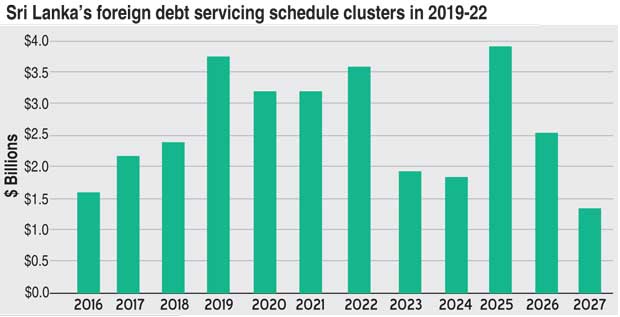01 Aug 2017 - {{hitsCtrl.values.hits}}
2019-22 external debt maturities stand at a mammoth US $ 13.8bn
Despite deal, external vulnerability jumps to a new high: Moody’s
CB under pressure to appease IMF as reserve target stands at US $ 7.4bn for 2017
Domestic debt set to reach a peak in 2018 pressurizing interest rates

Despite the Hambantota port deal would provide a temporary respite to the country’s ailing external sector by way of boosting its foreign exchange reserves, such proceeds by no means would be adequate to alleviate the medium-term challenges that are far more acute, given Sri Lanka’s higher debt obligations, according to Moody’s Investors Service.
During the weekend, despite the reservations of even some of the ruling party legislators, the government went ahead with a deal to sell the majority stake in the Hambantota port to China Merchants Port Holdings Company Limited for US $ 1.12 billion under a 99-year lease agreement.
In perspective, Sri Lanka’s external debt maturities during the 2019-2022 period are a whopping US $ 13.8 billion, compared to the country’s meagre gross official foreign exchange reserves of US $ 6.9 billion by the end of this June.
“Although the Hambantota receipts will ease external pressures, we expect those challenges to remain, given the persistent elevated government debt and large borrowing requirements,” Moody’s said in its latest credit outlook yesterday.
Moody’s said the proceeds, if received, would boost foreign exchange reserves and thus become credit positive but far from solving the country’s much deeper external vulnerabilities.
“The deal is credit positive for the sovereign because it will boost foreign exchange reserves, which will ease the government’s external liquidity position ahead of several large international bond payments in 2019-22,” the rating agency said.
Moody’s has a speculative B1 rating on the Sri Lankan sovereign with a ‘negative’ outlook.
However, even after the proceeds are received, there is a significant increase in the country’s external vulnerability as measured by Moody’s external vulnerability indicator, “which measures the ratio of external debt payments that are due over the next year to foreign exchange reserves, to rise to about 183 percent in 2017 from around 150 percent in 2016”.
Out of the US $ 6.9 billion gross official foreign exchange reserves by end-June, the foreign currency reserves portion of the gross reserves was slightly under US $ 6.0 billion, covering about 3.75 months of imports, just above the International Monetary Fund’s (IMF) minimum reserves adequacy threshold of three months.
Despite the concerns expressed by India and the United States due to growing Chinese foothold in Sri Lanka, the government went ahead with the Hambantota port sale to make good on the promise given to the IMF as the Central Bank is tasked with meeting a reserve target of at least US $ 7.4 billion by end-2017.
To stay in line with the IMF’s conditions of meeting the net international reserves target, much of it should consist of non-borrowed reserves.
Sri Lanka has been in the habit of running easy money and fiscal policies to boost growth just to end up with burning crucial foreign reserves and then driving the country into a balance of payments (BoP) crisis.
Sri Lanka’s BoP position remains vulnerable after foreign-currency reserves materially declined in late 2016 and early 2017. More recently, the reserves have risen somewhat because of the capital inflows from the international sovereign bond issuance and syndicated loans.
While Sri Lanka’s external debt maturities are set to reach a peak from 2019 onwards, the country’s domestic debt repayments will also reach a peak next year causing much borrowing pressure on the domestic market and the interest rates.
09 Jan 2025 32 minute ago
09 Jan 2025 1 hours ago
09 Jan 2025 1 hours ago
09 Jan 2025 1 hours ago
09 Jan 2025 2 hours ago